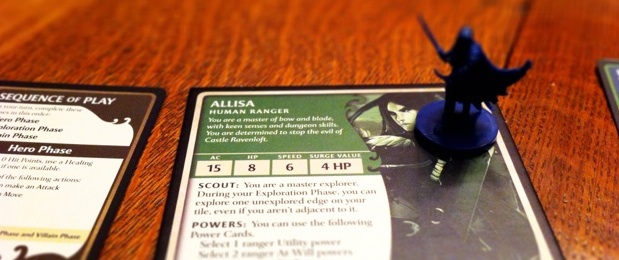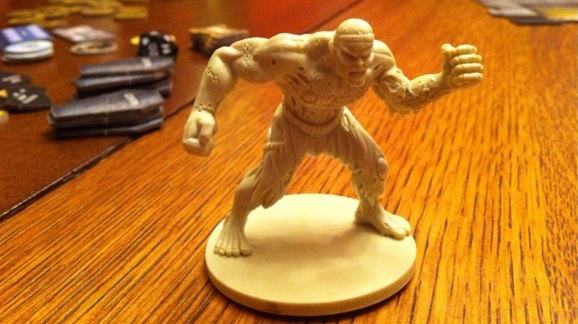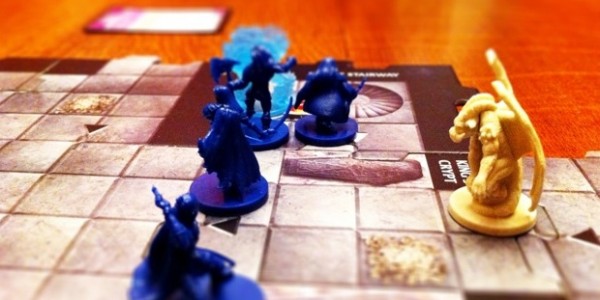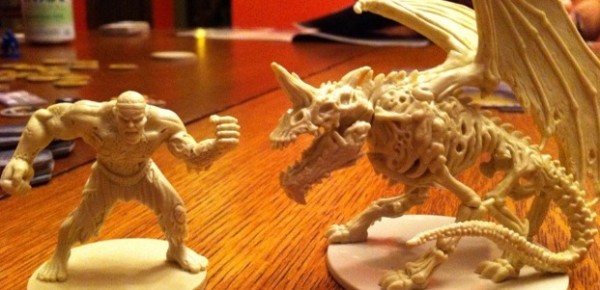

Are you like me? Do you have an insatiable need for tasty sandwiches and frozen grapes? Have you ever wanted a better way to get into the giant realm of Dungeons & Dragons but couldn’t find a proper conduit from “knowing nothing about it” to “getting ganked by thirty undead kobolds in an alley behind the inn?” Well, sir (or madame), there may finally be an answer. The recently released Dungeons & Dragons: Castle Ravenloft Board Game could very well be just for you.
When most people think about D&D, there are but a few different thoughts towards the game and those who play it: 1.) “Stupid nerds! That’s a stupid game for dumb nerds who like to sit around doing dumb nerd stuff! I would never play that nerd crap; now if you will excuse me, I have a fantasy football bracket to fill out.” and 2.) “That looks too difficult and time consuming. I think I will pass.” Every once in a while you will get the “yeah, I play D&D” crowd, but they are usually too busy constructing a new encounter for their group to even talk to you. And this is where Castle Ravenholt comes in.
Created in a way to make concepts of Dungeons & Dragons “easy,” Ravenloft retains a lot of the core gameplay mechanics of 4th Edition D&D, but streamlines it in a way to make those who have never cracked open the dense Player’s Handbook feel comfortable with adventuring into the depths of a scary vampire castle. At the outset, 1-5 players choose a character from one of the five available for play. There is a cleric, rogue, wizard, ranger, and fighter. All of these characters come with a pre-made character sheet with their basic stats and abilities. A stack of daily, at-will, and utility cards comes with each adventurer, and you have free reign to choose what you wish in each encounter.
Once your team is assembled, you look into the included encounter guide and choose what you will be playing. The guide comes with about ten or twelve different encounters that both ramp up the difficulty (in some cases) and change variables with how pieces act, making for more varied gameplay each time. For example, the first game I played went by the rules to a “T,” essentially, as it was the starting scenario that got everyone accustomed to the game. The second, however, had a rule that allowed players to gain more abilities as the game progressed, effectively helping with the added difficulty.

After the characters and the encounter are chosen, it’s time to play! But how the heck do we do that?! D&D is hard! Fear not, for everyone gets a handy guide card that tells you how the three phases of your turn go:
-
Hero Phase
- This is where you get to kick butt. Is there a monster near you? Go kick his butt! Use your abilities, the included D20 (because there has to be one of those), and rock his face.
- Unlike regular D&D, you don’t really have to worry about more obscure things like blasts or bursts. There’s no prone or squeeze or shift or grabs. Line of sight is about as far as this game goes. Can you see it? Rock it.
- You’ve killed the thing you wanted to kill. Now you can open up new areas of the map if you have positioned yourself to do so.
- The game comes with a huge stack of tiles that make up the game board. They are all square and have interlocking edges. When your character gets to a space that is on the edge of a tile, you have the option to “explore” and put another one of these tiles into the game, making new corridors and rooms. But with new rooms comes…
- Mosters! When a new tile comes into play, that pretty much means a new monster appears. You get their monster card, and your party has a new thing to kill. (There are about 40 miniatures in the box, by the way, so that means about 35 awesome monster figurines that can be easily used in any D&D campaign.)
- And that brings us to the Villain Phase. Now it’s time for the bad guys to attack. Remember that card you just got from opening up that room? Well now he activates and wants to chomp on your face.
- The villain phase is how the game gets away with having no DM (dungeon master) to pull the strings. On the moster card are all the things the monster can do, and it has rules for certain situations. For example, if your monster is a Rat Swarm and you are on his same tile, he will go over to you and attempt to chomp your face. If everyone happens to be on another tile, all he can do at that point is move closer to an adventurer and hope to chomp some face on the next turn.
- The Villain Phase is also when you activate any traps that might have come up as well.
Exploration Phase
Villain Phase

And that’s the basic structure of a turn. Everyone goes and kills things and hopes to open up new rooms to try and get to the final goal. In our first game, the goal was to find an artifact and steal it from the castle, all while killing off the guards in the room. The tile for that room was mixed in to the giant deck of tiles between tile eight and tile twelve. You can always see by looking at the board about how close you are to the tile in question, but it’s always a mystery, and the since the board grows based on how your team plays, it will always be in a different place and under different circumstances.

The one downside, and this is the downside that you will read from every discussion of this game, is that at certain times the rules are not perfectly clear on how to work your way through a situation. Regular D&D doesn’t have this problem because the 4th Edition Player’s Guide has 300 pages and ample time to explain it all. There were three of us in the room that had D&D 4E experience, so in the rare times that something didn’t make sense we just fell back onto those rules and it was fine. People who have never played regular D&D might have some consternation here and there, but it happens so little that it won’t make this game any less awesome.
I suggest you look into Castle Ravenloft if you have any interest in both D&D and modular, adventure-style board games. Playing a couple of encounters is a great way to spend an afternoon.